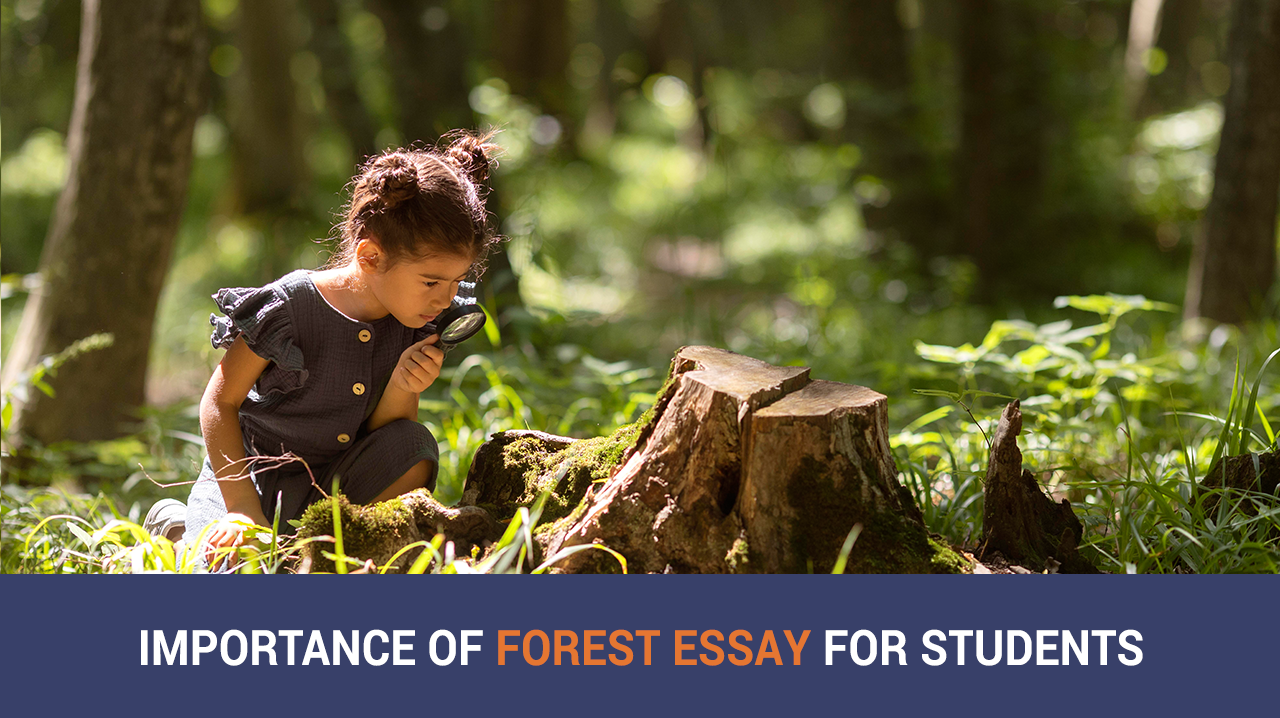Importance Of Forest Essay For Students

Walking through the traffic while inhaling the gases released by vehicles sometimes makes us sick and dizzy. Now imagine what it could do if there were nothing to absorb the harmful gases. That is where the significance of forests and trees comes in, as it purifies the atmosphere and provides us with oxygen to breathe.
In fact, the importance of forest resources can be indicated by the fact that all living beings’ survival largely depends on global terrestrial biodiversity. Unfortunately, that has not stopped anthropogenic activities and pollution from hampering the forests. As a result, animals have been losing their habitat, and it also leads to soil erosion.
Why Is Forest Important?
Forest lands comprise 31 percent of the total land on the Earth’s surface, covering over 4.06 million hectares of land. Furthermore, it is critical for sustaining life on the planet, providing oxygen, food, shelter, fuel, etc.
Importance of Forests
- Forests are home to more than half of the world’s land-based species of animals, plants, and insects.
- Forests are instrumental in maintaining the oxygen and temperature levels of the atmosphere.
- Forests prevent soil erosion and floods.
- Forests have particularly rare plants with medicinal value that helps in fighting diseases.
- They absorb harmful gases, helping to fight global warming.
Also Read
- Who Invented Zero
- Top 10 Impressive & Interesting English Speech Topics for Students
- Effects Of Sleep Deprivation For Students
- Importance Of Parent Teacher Meetings At School
Importance of Forest Essay
Forests are a natural habitat for animals, birds, insects and plants; they provide shelter and food. However, it is just as essential for the survival of human beings because the trees and plants supply us with oxygen, without which we won’t be able to breathe.
In fact, when we read the importance of forest essay, we can observe that many factors go into making forests an integral part of Earth’s sustenance. For instance, ninety percent of the planet’s species rely on plants, trees or shrubs.
Furthermore, one can read the importance of forest essay to find out vital details such as one acre of mature trees can provide oxygen for eighteen people. More importantly, they act as an air purifier, helping to absorb carbon dioxide and pollutant gases such as sulphur dioxide.
Forests provide green cover, which absorbs the Sun’s radiation, helping to keep the temperature down and regulating it through evapotranspiration and breeze. Also, the significance of forests can be highlighted in the fact that it regulates rainfall and helps maintain the water table and cool climate.
Moreover, it plays an integral role in the water cycle process; the forests facilitate water evaporation, condensation, and precipitation. In addition, they provide nourishment to the aquifers, which helps replenish groundwater supplies. Besides, trees enable rainwater to trickle down the trunk and into the soil, preventing the stormwater from carrying pollutants into the ocean.
Apart from the environmental benefits, there are many economic advantages, which we can count among one of the 10 importance of forest. Every part of a tree is useful to humans, including the bark, seeds, fruits, logs, pulps, stem, etc.
No wonder, throughout different time periods, people have been using it in their daily activities, whether in the form of medicine or to make paper to write. As the years rolled by, we learned new ways to utilise forests for various needs, including land, raw materials, wood, medicine, rubber, etc, thereby increasing the importance of forests.
What Are Forest Resources?
Forest resources are varied goods and services that we acquire from forests and other woodlands. People use these goods and services for multiple purposes, including economic activities, recreational activities, and subsistence.
Moreover, the importance of forest resources can be identified from the increasing demand for timber, food, fuel and other materials. For example, timber is one of the most popular and essential resources, as it is vital for furniture and paper production.
What Is Forest Conservation?
Forest conservation is the practice of maintaining the natural resources within a forest as it is beneficial for both humans and the environment. Therefore, it involves strategies to mitigate the harmful effects of human activities and environmental pollution.
For example, deforestation is one of the primary causes of reduction in green belt or forest areas across the world. Therefore, strategies to preserve and protect the forests are essential; afforestation and preservation of natural resources are among important strategies along the following:
- Complete avoiding of deforestation is not possible; therefore, selective cutting of trees and not cutting young or premature trees is vital.
- Forest fires have been deadly in the past, contributing to the burning down of large masses of forested areas. These occur due to natural or man-made causes; the importance of forests lies in protecting the forests against such instances through well-planned precautions.
In Conclusion,
Forests are integral to our survival, and we depend on their sustenance, which is exactly what MIT Gurukul often reminds its students. The renowned institute, famous for its multidisciplinary approach, inculcates the significance of forests from the early years itself. As a result, they develop a sense of responsibility and awareness towards the environment, which they also implement in their daily lives.

